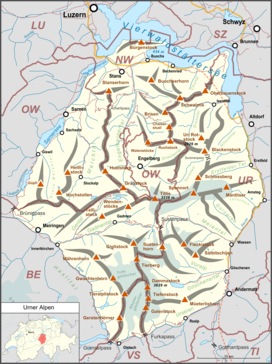Urner Alps
| Uri Alps | |
|---|---|
| Urner Alpen | |
|
The Dammastock from the Göscheneralp
|
|
| Highest point | |
| Peak | Dammastock |
| Elevation | 3,630 m (11,910 ft) |
| Coordinates | 46°38′28″N 8°25′6″E / 46.64111°N 8.41833°ECoordinates: 46°38′28″N 8°25′6″E / 46.64111°N 8.41833°E |
| Geography | |
| Country | Switzerland |
| Cantons | |
| Parent range | Western Alps |
| Borders on | |
| Topo map | Swiss Federal Office of Topography swisstopo |
The Uri Alps (German: Urner Alps) are a mountain range in Central Switzerland and part of the Western Alps. They extend into the cantons of Obwalden, Valais, Bern, Uri and Nidwalden and are bordered by the Bernese Alps (Grimsel Pass) and the Emmental Alps to the west (the four lakes: Lungerersee, Sarnersee, Wichelsee, and Alpnachersee), the Schwyzer Alps to the north (Lake Lucerne), the Lepontine Alps to the south (the valley of Urseren with Andermatt) and the Glarus Alps to the east (Reuss).
The Uri Alps are composed of two distinct groups separated by the Susten Pass. The massif on the south is the most glaciated part while the northern part, which culminates on Titlis, has lower summits but greater extent.
The group south of the Susten Pass forms the dividing range between the head waters of the Aare (west) from those of the Reuss. In addition a small portion of the range (south-west) is located in the basin of the Rhone. This part lies entirely within the valley of the Rhone Glacier. This group forms a complex mass including four considerable ridges and attains its greatest height at the and the . The group includes four nearly parallel ridges running NNW. and SSE. That forming the eastern boundary of the valley of Hasli reaches 3,383 metres at the , whence it extends NNW. to the Mährenhorn, and south to the Gärstenhörner. A wide reservoir of snow whence the Trift Glacier flows to the north and the Rhone Glacier to the south, divides this range from the more easterly range whose highest point is the . North of the Dammastock the range collectively known as the Hinter Tierberg, attains 3,447 metres. Further east than the last is the Sustenhorn range, rising at its highest point to 3,505 metres, divided from the last by the Stein Glacier and the upper part of the Göschenental. Lastly, another ridge still further east is separated from the last by the Voralptal, a branch of the Göschenental. Its highest summits are the and the . The lower part of the Göschenental is bounded on the south by a range running west to east diverging from the ridge between the Dammastock and the Galenstock.
...
Wikipedia

